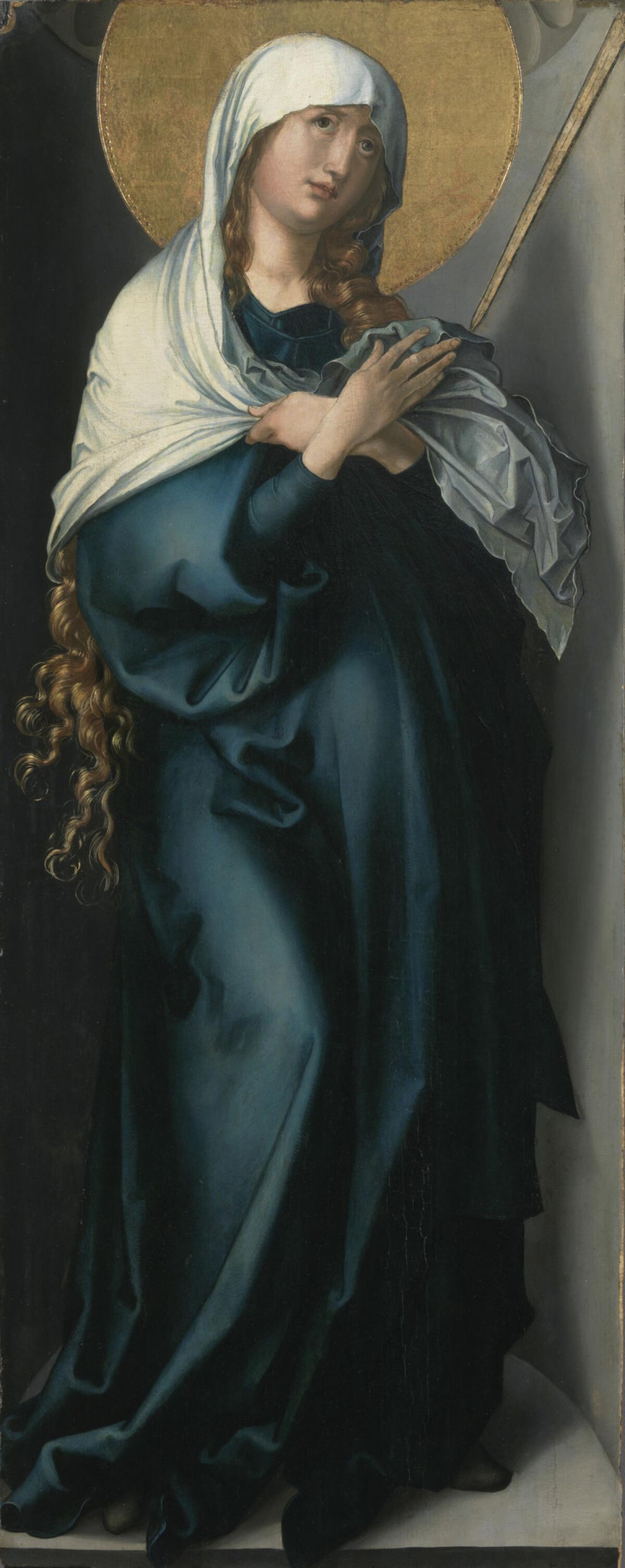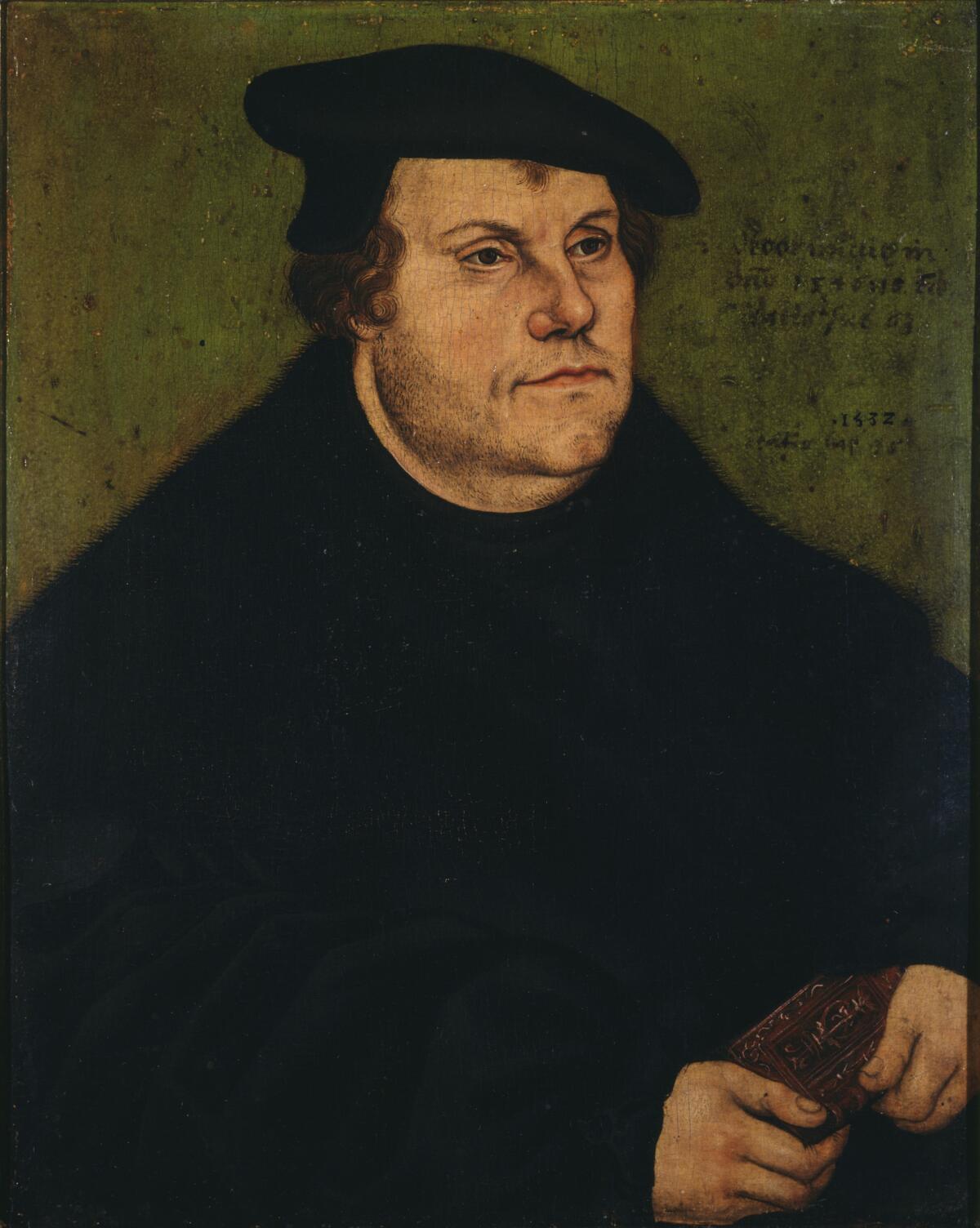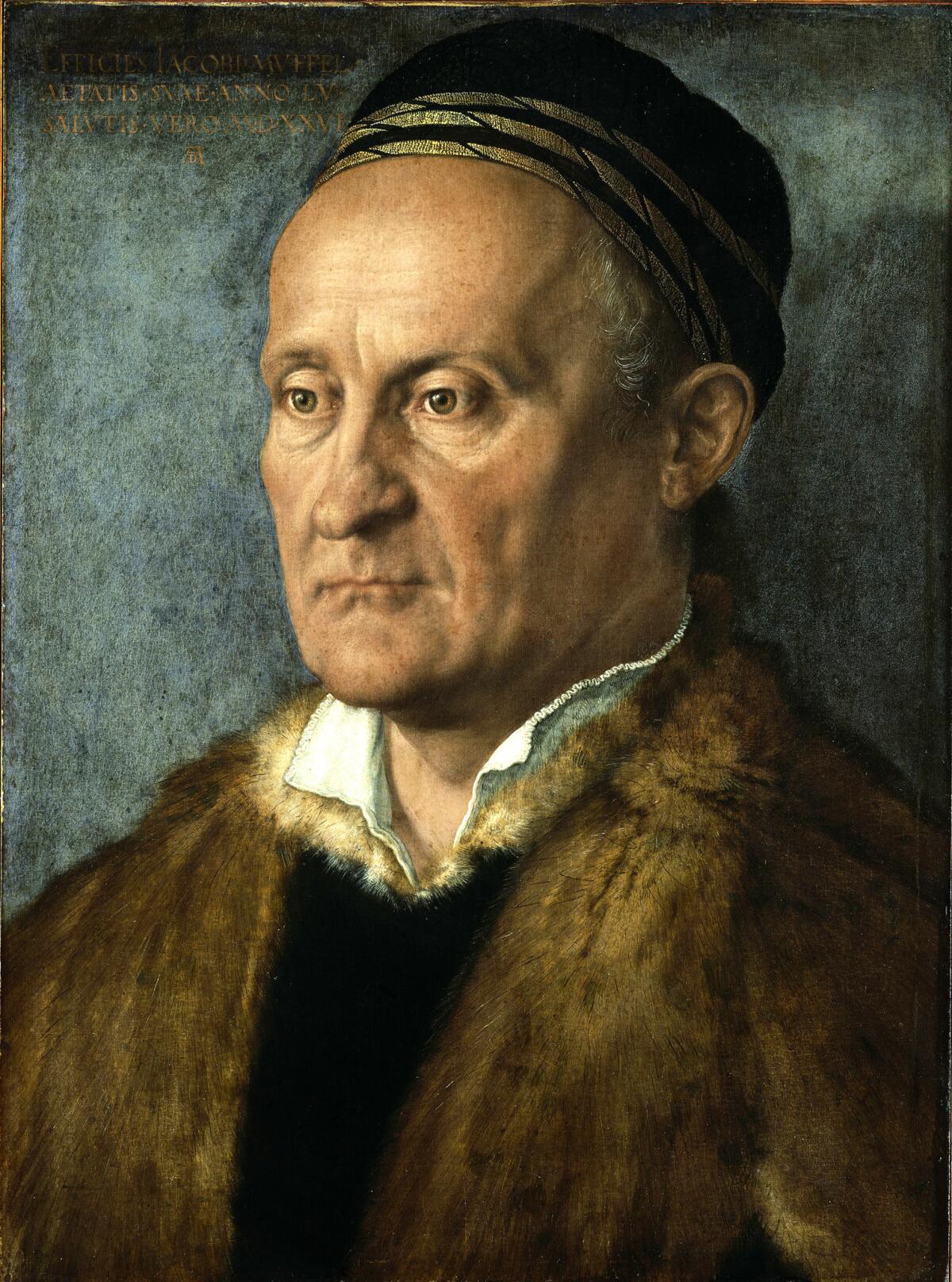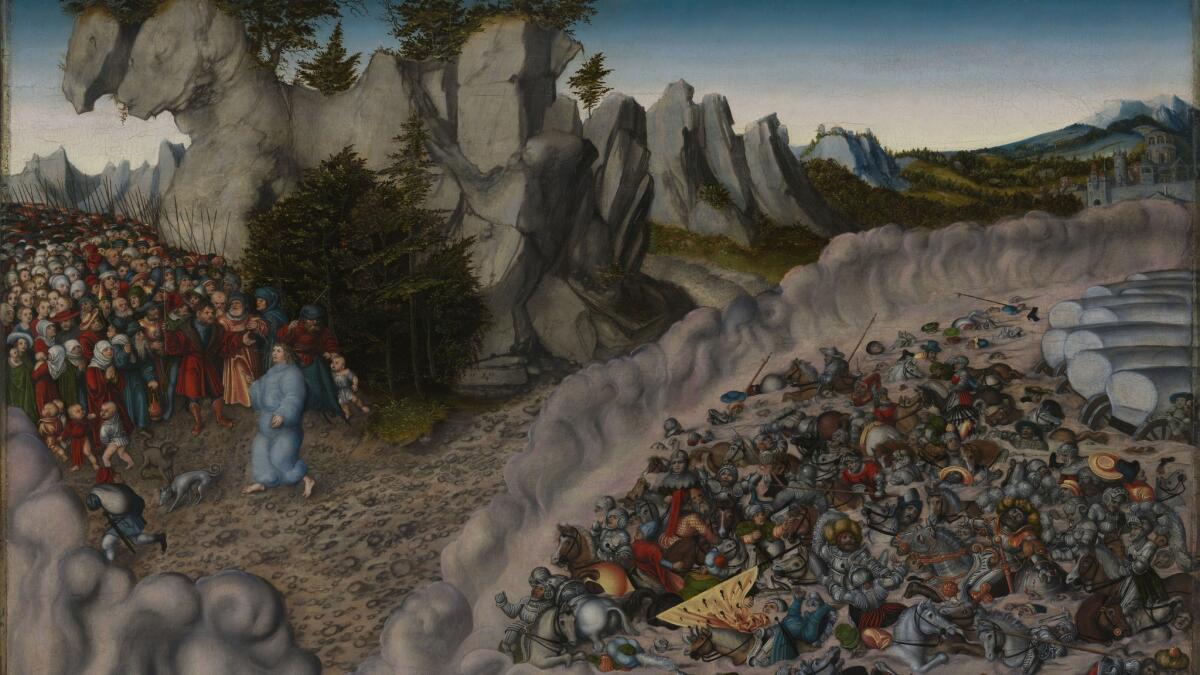Review: Martin Luther broke Europe in two, and Albrecht Dürer painted it back together
Martin Luther (1483-1536) had planned to become a humdrum lawyer, acceding to his father’s wishes. Instead, he broke Europe in two.
The 500th anniversary of Luther’s Protestant revolt against the Roman Catholic Church comes next year, pegged to the autumn day in 1517 when the renegade Augustinian monk is said to have nailed his famous “95 Theses” to the door of the imposing All Saints’ Church in Wittenberg, Germany. To mark the transformative aftermath of the event, one of the most far-reaching in European history, several American museums are mounting exhibitions.
Prominent among them is the
The selections include the weird and the wonderful — and how could they not? The story of the Reformation is a tangled tale of powerful forces, popular and princely, wrestling over deeply held religious beliefs. The byzantine brew mixes the sacred and the profane.
It begins with the moral scandal of indulgences.


Those were a means by which a Catholic sinner might buy his way out of seemingly interminable purgatory after death, speeding directly into heavenly bliss. Indulgences were like get-out-of-jail cards — albeit not for free.
The magical thinking went like this: One could lead a virtuous life, modeling Christ’s humility, but however morally upright, it would never be enough. Only a saint, of which the Catholic Church had plenty, could bank sufficient good deeds to open heaven’s door straightaway.
Indeed, saints racked up more than they could ever use. Why let all that surfeit of goodness go to waste? Indulgences drew on the saintly bank. Buy some now from the pope, and you were good to go for the afterlife.
Luther insisted otherwise: Personal faith was enough for salvation.
The exhibition opens with a gathering of saints, capped by two large, magnificent lime wood carvings by the great Tilman Riemenschneider.
Both are unpainted, an unusual characteristic of his work. Deep carving exploits shadows and highlights to articulate dramatic form.
St. Matthias is a subtly torqued figure, from the left-facing foreground foot up through the gently turning body to the right-facing head. The Virgin Mary’s slender body is elongated, perhaps to optically compensate for the sculpture’s likely placement in a high niche.
The subtlety of her design is nonetheless powerful. Thick, curving folds in Mary’s robe emanate outward from her womb, from which a lively baby Jesus arises. He’s like the reverse of a pebble tossed in a pond, energy rippling outward.
A similarly strange compositional maneuver marks “The Holy Trinity,” one of eight paintings by Lucas Cranach the Elder, who is a star of the exhibition. Cranach’s painting is installed opposite Riemenschneider’s sculpture.
But, there’s a stark difference: The limp, battered body of a crucified Christ emerges from the labial folds of the robe worn by God. Oval layers of crimson cloth echo the almond shape of a radiant mandorla within which the Trinity hovers. The father gives metaphorical birth to the son, sanctified by the winged dove of the Holy Spirit.
The Cranach, painted before the artist left the Catholic Church and embraced Protestantism, is an astonishing image of Christian patriarchy. Those masculine prerogatives are most easily seen in the show’s marvelous selection of portraits.


Among them is the famous little picture of Luther, Cranach’s friend and neighbor in Wittenberg. The portrait is a private devotional image barely 7 inches high. Luther is shown as a scholar conspicuously holding a book with both hands. Think secular saint.
Given the decline in demand for religious paintings in Protestant Germany, portraiture rose in prominence. Luther advocated moderate emancipation for women, but of the show’s 10 portraits, only one is female — an upper-class wife rendered by Batholomäus Bruyn the Elder.
Her dependent status in relation to the adjacent portrait of her husband is signaled by the carnation she holds up — a symbol of marital affection. He holds gloves, sign of a gentleman. The paintings are finally all about him.
The most riveting portrait, unsurprisingly, is by Albrecht Dürer, Germany’s greatest Renaissance artist. It’s one of three panels by him in the show — to my knowledge, the first ever to be sent to Los Angeles and reason enough to go. (A separate Dürer print show opens Dec. 17.) The picture, painted just before its subject died, is a rich catalog of tactile beauty — soft fur, crepuscular skin, crisp linen, silken hair, coarse embroidery.
Jakob Muffel, the sitter, is not a mannered symbol. He’s unique flesh and blood occupying a voluptuous material world. He and Dürer’s singular painting meet on common ground.
This profoundly humanist brand of portraiture went international. Hans Holbein the Younger exported it to the court of England’s Henry VIII, represented by a double portrait of a ruddy notary and his prosperous son.

Of two dozen paintings total, all but one of the remaining female images is biblical, the Virgin Mary or Eve. The exception is — well, exceptional.
Cranach’s exquisite “Lucretia” casts an ancient Roman heroine as a secular Venus. He adapted the willowy nude from an earlier painting of the mythological goddess. But here Cranach slips a long dagger into her hand, the tip of its blade pressed beneath her breast as she prepares to commit suicide.
Lucretia had been raped by the son of an enemy king. The dreadful (if popular) historical legend cast her suicide as the ritual restoration of her honor. Cranach pulled a delicate, transparent veil across her naked sex, the imminent piercing of her body by one weapon juxtaposed with the memory of another.
Cranach’s painting is brilliant, while the cruel social creed that Lucretia represents is wicked. Such was the norm. A wall label notes that between 1500 and 1750, nearly 100,000 women were burned at the stake as heretical witches, vulgar subject of a Hans Franck drawing.
Masculinity and violence form the subtext of a remarkable gallery of lavishly decorated ceremonial arms and full suits of armor. Take the cylindrical cartridge box for a pair of extravagant pistols, all three inlaid in gold and silver: Its form is a blunt phallus.
Nearby, a gilded helmet lined in velvet and embossed with ancient battle scenes features a tall ridge along the skull from forehead to neck. This exquisite golden crescent is a virtual halo. It consecrates the soldier’s sacred purpose as surely as the one Dürer painted on his Virgin Mary, mother of sorrows.
An epic battle painting by Melchior Feselen presents legions of massing soldiers, each one a distinct and individual personality. (It’s more than 5 feet tall.) Another by Cranach shows Egyptians being swallowed up by the Red Sea as fleeing Israelites huddle beneath protective cliffs given hallucinatory animal forms — nature as protector.

At the other end of the spectrum, though equally important to the blockbuster clash between Luther and the Roman Church, is a fascinating selection of 15 inexpensive propaganda broadsheets.
Hans Brosamer’s outlandish woodcut gives Luther seven heads — the Book of Revelation’s Beast of the Apocalypse. In a grotesque Melchior Lorch etching, the furry, donkey-eared man spewing snakes, scorpions and vermin from his mouth, a pig riding on his shoulder, also wears a papal crown. It’s easy to tell which side of the fight each artist occupies.
With these mass-produced prints, the modern media age dawns. Gutenberg’s mechanical printing press allowed for their wide public dissemination, as it did for the Bible — translated by Luther from mysterious Greek and Latin into accessible German. From the privileged text of a closed priesthood, the Bible went open-source.
Dürer is our first great media artist. His intimate, exquisitely wrought engraving of a contemplative St. Jerome working alone in his study circles back on the precedent for Luther’s achievement: It was Jerome who translated the bible from ancient Greek and Hebrew into then-contemporary Latin.
LACMA’s show, copious if inevitably not comprehensive, does an excellent job of translating 16th century German culture into a revealing 21st century exhibition. It even links to modern artistic conventions, since Dürer — an ambitious egoist who monogrammed almost everything he made — was the first artist to use media as a branding tool. The museum has a reputation for organizing important shows of German art, mostly from the modern era, and “Renaissance and Reformation” impressively extends the range.
Plus, there’s an unexpected benefit. Luther’s 500th anniversary was its impetus, but the show’s focus on art during a period of deep moral crisis couldn’t be timelier, given the threatening upheaval Americans are experiencing today. Coincidental, the concurrence is also critical.
------------
“Renaissance and Reformation: German Art in the Age of Dürer and Cranach”
Where: Los Angeles County Museum of Art, 5905 Wilshire Blvd., L.A.
When: Through March 26. Closed Wednesdays.
Information: (323) 857-6000, www.lacma.org
christopher.knight@latimes.com
Twitter: @KnightLAT
ALSO
John McLaughlin at LACMA: The most important postwar artist you may not know
Paul Sietsema's first L.A. show of new Conceptual art was worth the 14-year wait
The biggest entertainment stories
Get our big stories about Hollywood, film, television, music, arts, culture and more right in your inbox as soon as they publish.
You may occasionally receive promotional content from the Los Angeles Times.








